Interaction design helps people use digital products easily and enjoyably. It focuses on making apps, websites, and other tools simple to understand and use. Designers create user flows, wireframes, and prototypes to show how people will move through a product.
The goal of interaction design is to help users reach their goals with little effort. It reduces confusion and makes using digital tools smoother and more satisfying.
As more businesses move online, good interaction design becomes more important. A clear and attractive design helps products stand out and keeps users coming back. It can also help a business grow and succeed.
But poor design has the opposite effect. If a product is hard to use, people may stop using it altogether. That’s why skilled interaction designers matter. They build user-friendly and accessible designs that make people’s digital experiences better and help companies stay ahead.
Key Takeaways
Interaction design focuses on making digital products easy, intuitive, and enjoyable to use. Here’s a quick overview of the most important points to remember:
1.
It focuses on clear, intuitive user experiences.2.
It helps users move easily through digital products.3.
Designers use flows, wireframes, and prototypes.4.
Good design reduces confusion and boosts satisfaction.5.
It centers on how users interact with interface elements.6.
The process includes research, testing, and feedback.7.
Demand is growing as more services move online.8.
AI, voice, and AR/VR are shaping future interactions.
Strong interaction design improves how people use technology every day.
What Is Interaction Design?
Interaction design (IxD) is a discipline that creates and structures interactive digital products and systems. It involves understanding how users interact with technology and designing interfaces that facilitate these interactions in intuitive and fulfilling ways.
User Experience Design and Interaction Design

The main goal of interaction design is to improve the user’s experience and satisfaction by making their interactions as simple and efficient as possible. This entails designing interface elements like buttons, menus, forms, and other interactive controls that are both easy to use and visually appealing.
The history of interaction design can be traced back to the early days of computing in the mid-20th century when the first human-computer interfaces were developed. The field evolved significantly during the 1980s and 1990s as personal computers became more prevalent, driving the need for more user-friendly interfaces.
The advent of the internet and mobile devices further transformed interaction design, pushing the boundaries of what was possible and necessitating more sophisticated and responsive design practices. Today, interaction design encompasses traditional web and desktop applications and mobile apps, wearable technology, augmented reality (AR), and virtual reality (VR) experiences.
Interaction Designer vs UX Designer
While interaction design, user experience (UX) design, and user interface (UI) design are related fields, they each have distinct focuses.
Interaction design primarily concerns creating interactive elements and ensuring these interactions facilitate effective user experiences. UX design is broader and encompasses all aspects of a user’s interaction with a product, including usability, accessibility, and overall satisfaction.
Relationship between UI, IxD, and UX
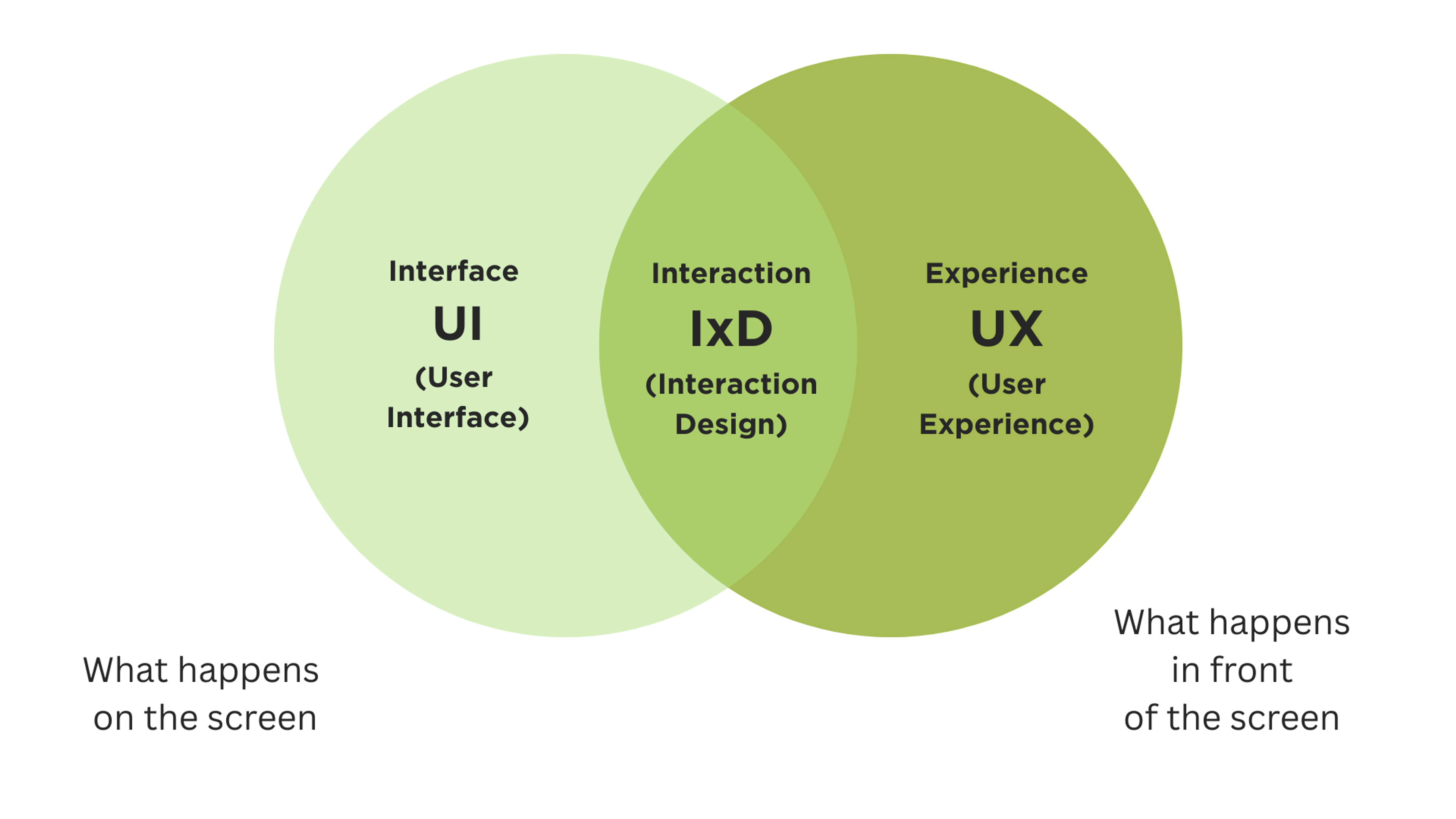
UX designers are responsible for optimizing these interactions and applying usability principles to create seamless, effective user experiences.
Conversely, UI design focuses on the visual elements of a product’s interface, such as layout, typography, and color schemes. These disciplines work to create cohesive and engaging digital experiences, but interaction design specifically zeroes in on the behavior and functionality of interactive components.
What Is an Interaction Designer?
Interaction designers play a pivotal role in developing digital products by ensuring that users can effectively and intuitively interact with them. Their work is significant because it directly impacts the usability and enjoyment of a product, which, in turn, affects user satisfaction and loyalty by considering how a user interacts with various elements of a product or system.
Interaction designers help create seamless experiences by focusing on the behavior of interactive elements and how users engage with a system.
What Does an Interaction Designer Do
An interaction designer is responsible for creating intuitive and engaging user experiences for digital products. Their primary goal is to enhance user satisfaction and usability by designing interactive elements that meet user needs. Key responsibilities of an interaction designer include:
- Overseeing the design and implementation of user interactions: Interaction designers focus on how users interact with a product, ensuring that these interactions are smooth and intuitive.
- Collaborating with cross-functional teams: Interaction designers work closely with UX designers, developers, and product managers to ensure that the design aligns with the overall product vision and objectives.
- Developing a deep understanding of user experience principles: A strong grasp of UX principles is essential for creating effective interaction designs that meet user needs.
- Providing strong leadership skills: Interaction designers often lead design projects, guiding teams through the design process and ensuring that the final product meets user expectations.
Key Responsibilities and Tasks
Conducting User Research
One of the first steps in the interaction design process is conducting user research. This involves gathering information about the target audience, their behaviors, needs, and pain points.
Methods such as user interviews, surveys, and usability testing help designers understand users and what they require from the product. This research provides the foundation for designing user-centric solutions that address real problems and enhance the user experience.
Creating Wireframes and Prototypes
After understanding user needs, interaction designers create wireframes and prototypes to visualize the product’s structure and functionality. Wireframes are basic, low-fidelity representations that outline a digital interface’s layout and essential elements.
Prototypes are more detailed and interactive, allowing designers to test and refine the product's flow and functionality before full-scale development. These tools are essential for iterating on design ideas and ensuring that the final product meets user expectations.
Benefits of Prototyping by Clay
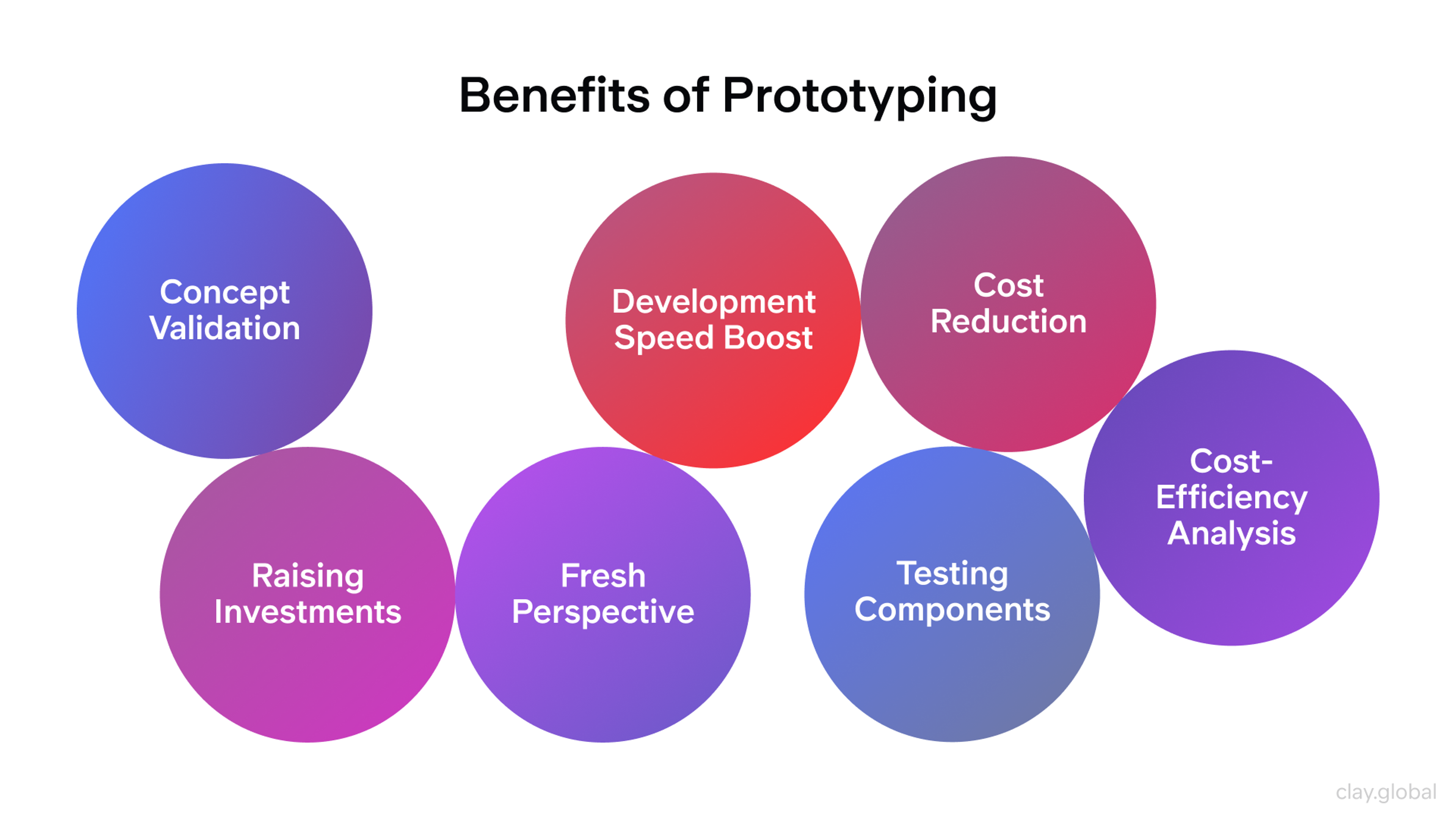
Our project for Corsair illustrates the role interaction designers play in creating intuitive and visually appealing interfaces. We developed a comprehensive component-based design system for Corsair that ensures consistency and ease of use across all digital products, including desktop software and mobile apps.
This system allows for easy customization and scalability while maintaining brand identity. Additionally, we updated iconography and established motion design guidelines that enhance the user experience by making interactions more fluid and visually consistent.
Corsair Design by Clay
Designing Interactive Elements and Interfaces
Creating interactive controls and interfaces is a key part of what interaction designers do every day. They focus on making buttons, menus, forms, and other elements look good and work smoothly. The goal is for every control to feel natural, so people can finish tasks without feeling lost or frustrated.
Error messages play an important role, too. They should tell users what went wrong and guide them on how to fix it or why it happened. Paying close attention to every detail and knowing solid design principles helps designers build interfaces that feel complete and engaging.
Testing and Revising Designs
Once the first designs are done, the work is far from finished. Interaction designers must keep testing and refining their work. Usability testing with real users gives them essential insights into how the design performs, exposing any problems and pointing to spots that need tweaking.
Using what they learn from users, designers keep adjusting the design, improving its ability to meet people’s needs. This cycle of testing and tweaking helps ensure the final product is truly user-friendly and practical.
Essential Skills for an Interaction Designer
Technical Skills
- Proficiency in Design Tools
Interaction designers must be proficient in using various design tools such as Sketch, Figma, and Adobe XD. These tools help create detailed wireframes, prototypes, and high-fidelity mockups, enabling designers to visualize and test their ideas effectively. Additionally, these tools facilitate the creation of visual representations, such as images, typography, and icons, which are crucial for simplifying complex processes and enhancing user engagement.
Typography Illustration by Clay
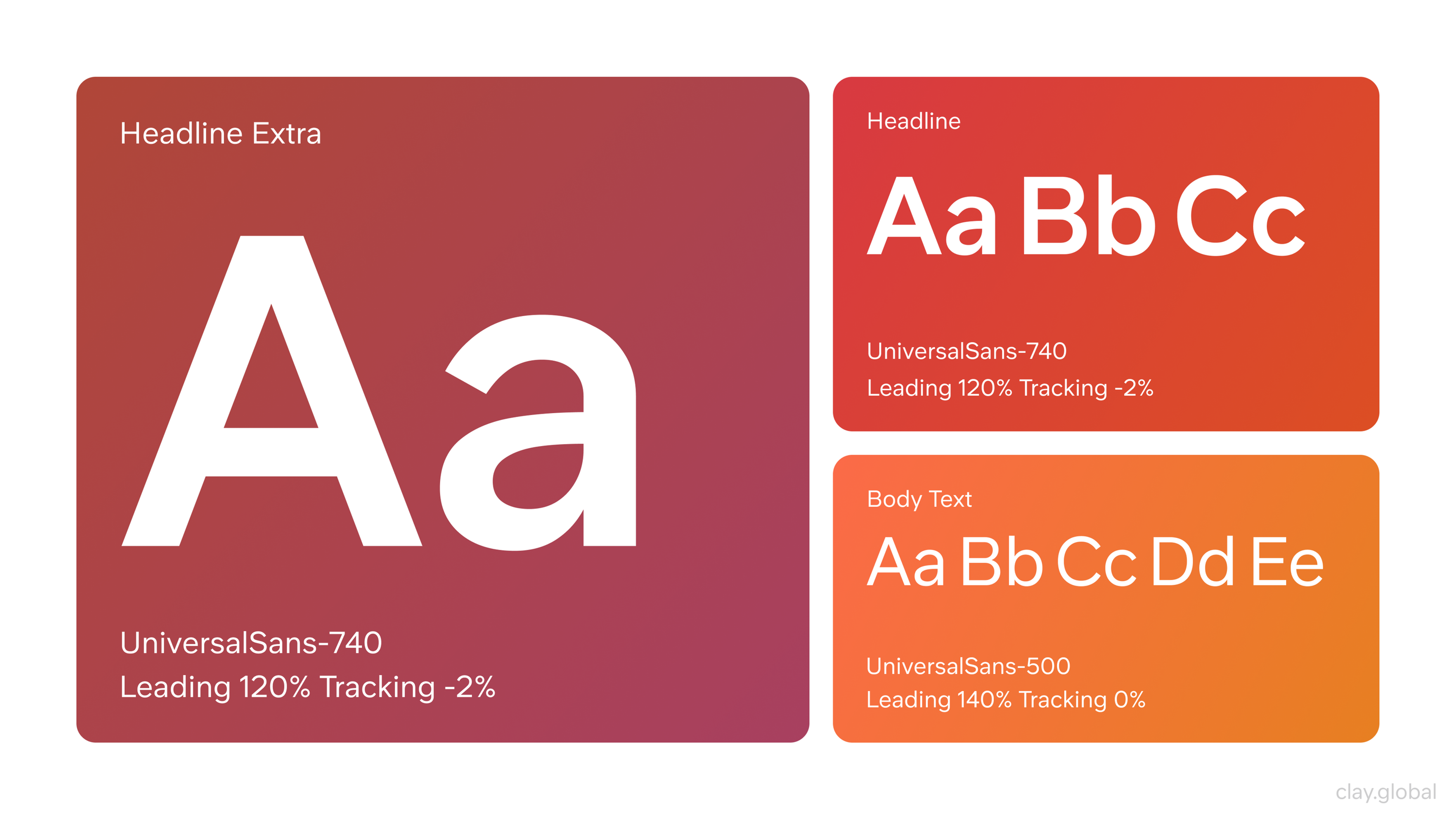
- Knowledge of HTML, CSS, and JavaScript Basics
Interaction designers must have a basic understanding of HTML, CSS, and JavaScript. This knowledge helps them collaborate more effectively with developers and ensures that their designs are feasible and can be implemented seamlessly in the final product.
- Understanding of User Research Methods and Usability Testing
Interaction designers should be well-versed in user research methods, including interviews, surveys, and usability testing. These skills are essential for gathering insights about user needs and behaviors, which inform the design process and help create user-centric solutions.
Soft Skills
- Strong Communication and Collaboration Abilities
Effective communication and collaboration are critical for interaction designers. They must work closely with cross-functional teams, including developers, product managers, and other stakeholders, to ensure the design aligns with the overall product vision and objectives.
- Empathy and Understanding of User Needs
Empathy is a cornerstone of interaction design. Designers must put themselves in the users’ shoes to understand their needs, pain points, and preferences. This user-centric approach is crucial for creating intuitive and satisfying interactions.
Source: Unsplash+

- Problem-solving and Critical Thinking
Interaction designers must possess strong problem-solving and critical-thinking abilities. They must analyze complex problems, identify potential solutions, and iterate on their designs to meet user and business needs effectively.
Interaction Design Salary
As of 2025, the average base salary for an Interaction Designer in the United States is approximately $95,000 to $120,000 per year, depending on experience, location, and company size. Entry-level roles typically start around $70,000, while senior designers and specialists can earn upwards of $130,000 annually.
Interaction Design Process
User Research Phase
User Interviews and Surveys
Conducting user interviews and surveys forms the backbone of the research phase. User interviews involve engaging directly with individuals from the target audience to gather qualitative insights into their behaviors, needs, and pain points. On the other hand, surveys enable the collection of quantitative data from a larger audience.
Together, these methods provide a comprehensive understanding of user requirements, ensuring that the design process addresses real user problems. It is also crucial to consider the physical objects involved in user interactions, such as laptops, touchpads, and smartphones, and the physical space they occupy, like standing in a crowded train or sitting at a desk.
Competitor Analysis
Analyzing competitors is also an integral part of the research phase. By studying existing products within the same market, interaction designers can identify successful strategies and areas for improvement. Competitor analysis helps uncover industry standards, innovative features, and potential gaps in the market, which can inform the design strategy and create a competitive edge.
Design Phase
- Wireframing and Prototyping
Once ample user research has been conducted, the design phase begins with creating wireframes and prototypes. Wireframes are basic sketches that outline the layout and fundamental elements of the interface, enabling designers to focus on core functionality. Prototypes are more detailed and interactive. These are essential for visualizing and testing the product's flow and interactive components before moving on to full-scale development.
- Iterative Design and Feedback Loops
The design process is inherently iterative. Initial designs are reviewed and tested, often involving feedback from users and stakeholders. This feedback loop allows designers to refine their wireframes and prototypes, making necessary adjustments to improve usability and meet user expectations. Iteration is crucial for creating a polished and effective final product.
Testing Phase
- Usability Testing
Usability testing is a cornerstone of the testing phase. Real users interact with the design to identify usability issues and areas for improvement. Observing how users interact with the product provides valuable insights into its effectiveness and any challenges users may face.
Core Elements of Usability Testing
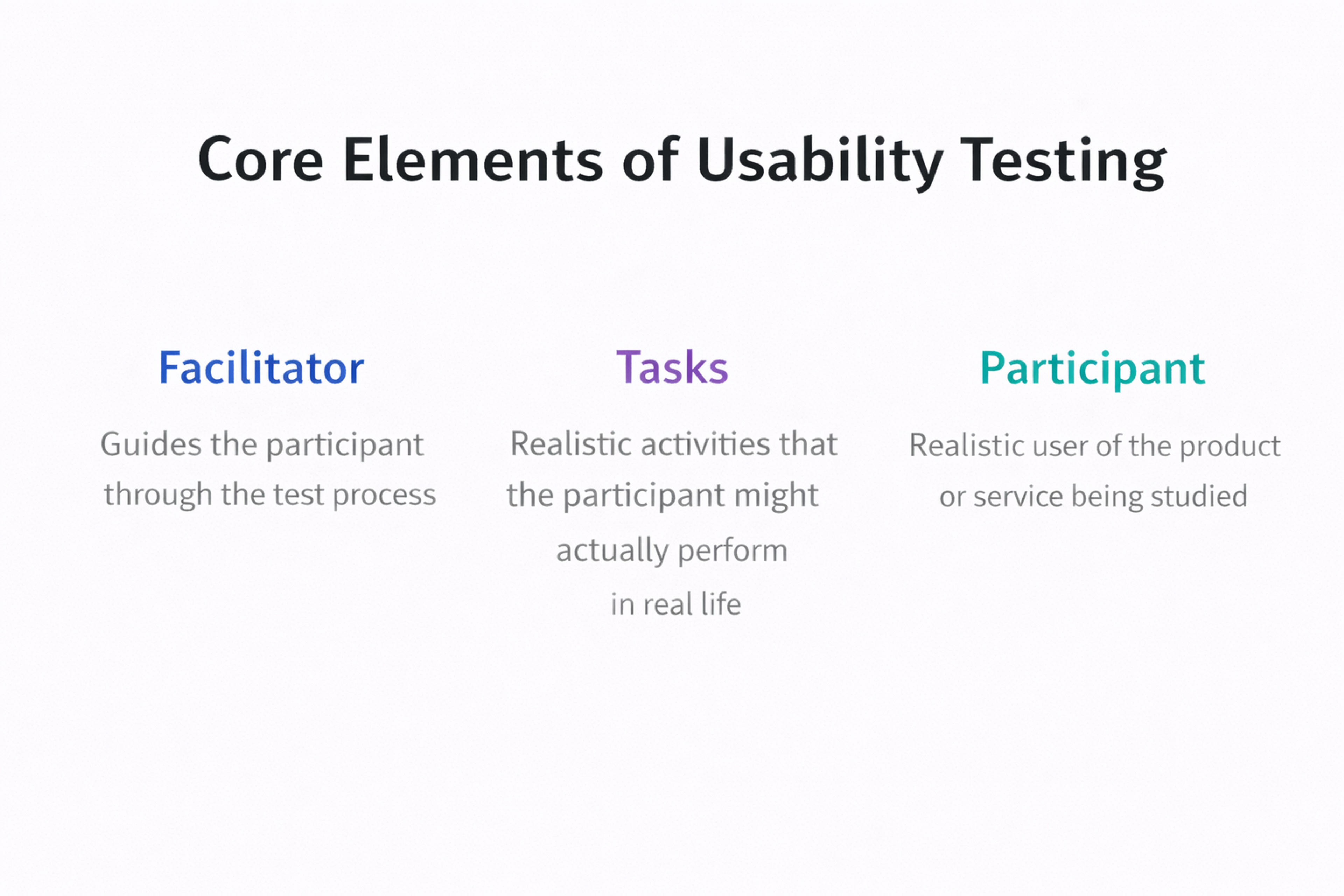
- A/B Testing
A/B testing involves comparing two design versions to determine which performs better. By presenting users with different design variations, designers can gather data on user preferences and behaviors, informing decisions that enhance the overall user experience.
- Gathering and Analyzing User Feedback
Collecting user feedback doesn't stop at usability and A/B testing. Continuous gathering and analysis of user feedback ensure the design evolves to more effectively meet user needs. This ongoing process helps identify areas for further improvement and ensures the product remains relevant and user-friendly.
Implementation Phase
- Working with Developers to Implement Designs
Interaction designers collaborate closely with developers in the implementation phase to bring their designs to life. Effective communication and teamwork are essential to ensure the design vision is realized accurately and seamlessly. Designers must ensure that all interactive elements are implemented as intended and provide developers with the necessary specifications and assets.
- Monitoring and Iterating Post-Launch
An interaction designer's work is not done after the product launch. Monitoring user interactions and gathering post-launch feedback is critical for identifying any issues or areas for improvement. Based on this data, designers continue to iterate on the design, ensuring the product evolves to meet user needs and expectations. This post-launch monitoring helps maintain high user satisfaction and long-term product success.
Career Path and Opportunities
Typical Career Progression for Interaction Designers
Interaction designers often start their careers in junior roles, gaining hands-on experience and honing their skills under the guidance of seasoned professionals. As they accumulate experience and demonstrate their abilities, they may progress to mid-level positions such as Interaction Designer or User Experience Designer.
Possible Career Paths of a UX Designer
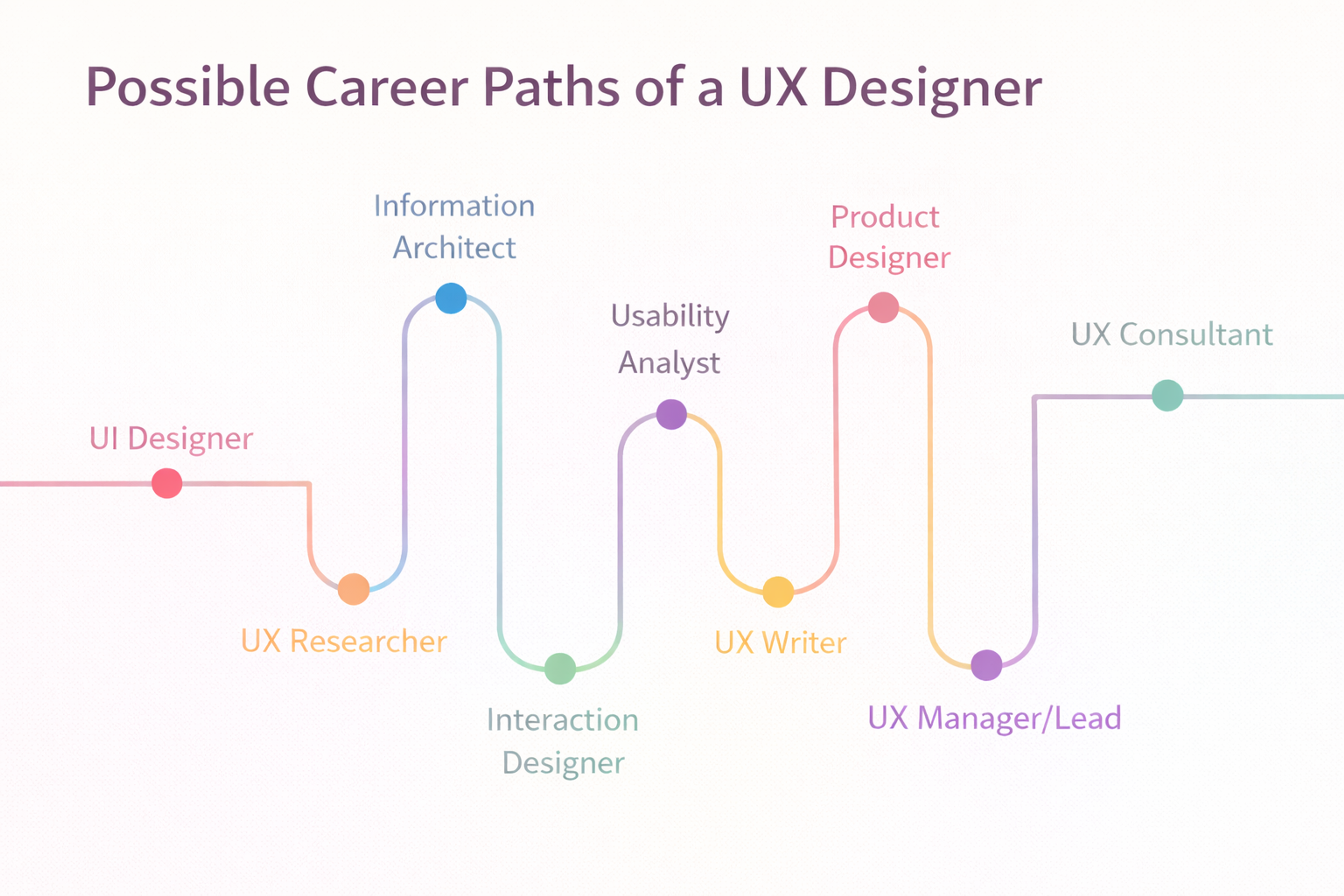
Senior roles, such as Senior Interaction Designer or Lead UX Designer, involve more strategic responsibilities, including overseeing design projects and mentoring junior designers.
Ultimately, experienced designers may advance to managerial or executive positions, such as UX Manager, Design Director, or Chief Design Officer, where they shape an organization's design vision and strategy.
Educational Background and Certifications
A strong educational foundation is important for aspiring interaction designers. Most industry professionals hold a bachelor's degree in graphic design, human-computer interaction, interaction design, or a related discipline. Some designers further enhance their expertise with a master's degree in a specialized design area.
Alongside formal education, certifications can bolster a designer's credentials. Online courses and certifications from platforms like Coursera and edX or organizations like the Nielsen Norman Group provide valuable learning opportunities in UX design, usability testing, and other essential skills.
Job Prospects and Industry Demand
The need for skilled interaction designers is stronger than ever and keeps climbing as digital experiences weave deeper into daily life. From major tech firms to hospitals and clinics, businesses in every sector are hiring interaction designers to craft easy-to-navigate interfaces and improve their digital offerings.
Mobile and web apps, Internet of Things (IoT) devices, and virtual and augmented reality (VR/AR) tech only heighten this demand. Because of this, job openings are plentiful and span nearly all fields, ensuring a bright future for anyone entering this profession.
Freelancing and Consulting Opportunities
Beyond full-time roles, interaction designers can easily step into freelancing or consulting. Freelancers enjoy the freedom to juggle various projects and often partner with several clients simultaneously. This enriches their portfolio and lets them pick work that excites them or matches their skills.
On the consulting side, designers provide specialized guidance to firms on user experience and interface design best practices. Both freelancing and consulting can be profitable and rewarding, blending creative freedom with the chance to start a small business.
Challenges and Future of Interaction Design
Common Challenges Faced by Interaction Designers
Interaction designers face several hurdles that make delivering great experiences challenging. First, keeping up with fast-changing tech and new design trends can feel like running in place. One day, it’s all about voice interfaces, and the next, it’s gestures or AR.
Second, designers keep walking the tightrope between what users want and what the company needs. Sometimes what’s suitable for the user doesn’t meet the bottom line, and that’s never an easy conversation.
Third, there’s the juggling act with stakeholders. Everyone has a different opinion, and timelines and budgets can shrink faster than a late-night delivery.
Finally, ensuring the design is accessible for everyone — from people with disabilities to older adults — adds extra layers of tests and tweaks. Designers want to be inclusive, but some teams take shortcuts and lose sight of the end goal.
The Future of Interaction Design and Emerging Trends
The future of interaction design is getting exciting fast. New technologies, combined with what users now expect, keep pushing the field forward. As these new trends emerge, they give designers fresh chances to create better experiences and bring fresh challenges to solve.
AI and Machine Learning
AI and machine learning are game-changers for interaction design. They let designers build interfaces that feel smarter and more personal. With AI, screens can now change instantly to match what a user is doing or what they like.
What Is Artificial Intelligence by Clay
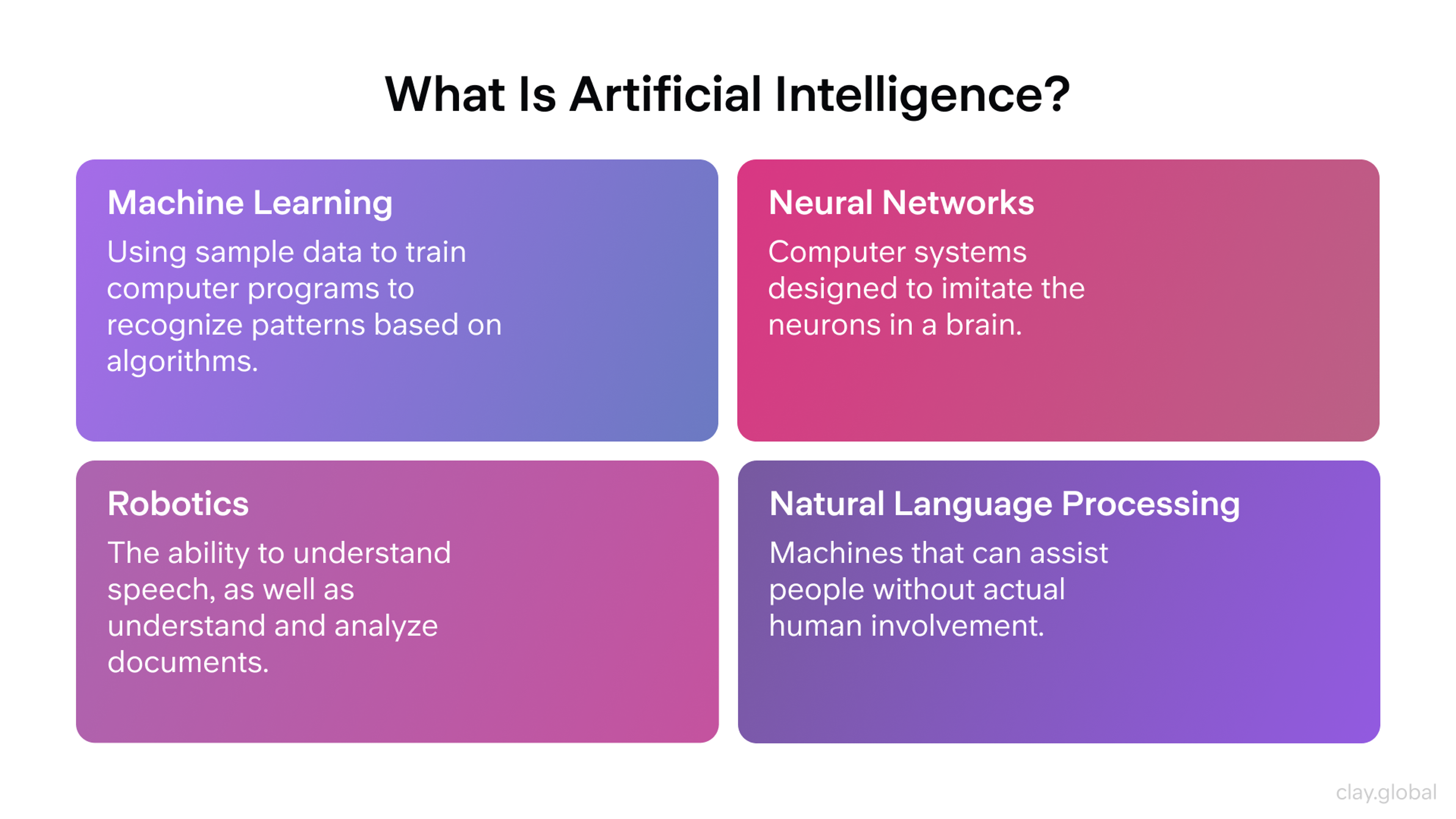
Machine learning takes that further by spotting patterns and predicting what the user might want next. This means designers can surface new features or content when the user most likely needs or enjoys it.
Voice and Gesture Interfaces
At the same time, voice and gesture controls are gaining ground. Devices powered by voice, like Alexa and Siri, let people engage with technology simply by talking. Gesture controls let users wave or point to make things happen, creating exciting, hands-free moments.
Designers now have to think differently: they need to build experiences that feel natural and effortless, while also considering users who might have different abilities. Making these new ways of interacting inclusive and straightforward will be key to the next wave of digital products.
Augmented Reality (AR) and Virtual Reality (VR)
AR and VR are changing the game for digital content by letting users step into experiences that mix the real and digital worlds. With AR, digital information is placed right on top of the real world, making everything from maps and directions to classrooms more interactive and valuable.
On the other hand, VR gives users complete digital worlds for gaming, training, and simulations, making each session feel real enough to touch. As both AR and VR reach more people, designers are challenged to build experiences that are both exciting and easy to use.
The future of interaction design is bright, with emerging technologies and trends pushing the boundaries of what is possible. By staying informed and adaptable, interaction designers can continue to create meaningful and impactful user experiences.
FAQ
Q: Can I Be Both a UX and UI Designer?
Yes, many designers work in both UX (User Experience) and UI (User Interface) design. These roles complement each other — UX focuses on how a product works, while UI focuses on how it looks. Having skills in both areas helps create seamless and attractive user experiences.
Q: What Is the Highest Paid Designer?
The highest-paid designers are typically UX design leads, creative directors, or product designers working at major tech companies. Specialized roles in UX research, design strategy, or AR/VR design can also command top salaries.
Q: How Much Do Interaction Designers Make Per Hour?
As of 2025, interaction designers earn about $45–$65 per hour on average in the U.S. Rates may vary based on experience, location, and project type, with freelance and senior roles earning more.
Q: What Is an Example of an Interaction Design?
A common example of interaction design is the “swipe to delete” feature on mobile apps. It’s a simple gesture that makes the user’s task clear and intuitive.
Q: What Is a Real Life Example of Interaction?
Using a touchscreen ATM to withdraw money is a real-life example. The interface responds to your input, guiding you step by step through the process.
Read more
Conclusion
As digital environments continue to expand and evolve, interaction designers' contributions will be central to how people connect with technology. The road ahead is dotted with complex challenges, yet there is an equal array of chances for breakthrough thinking and cultural impact.
Harnessing cutting-edge tools such as artificial intelligence, augmented reality, and virtual reality while monitoring shifting cultural and technological currents empowers interaction designers to redefine what user experience can be. They can build usable, efficient, joyful, equitable, and anticipatory interfaces.
Whether embedded in corporations, working as independent practitioners, or advising organizations, these professionals carve careers that prize imagination, nimbleness, and responsibility. Looking ahead, interaction designers' skills, reach, and authority will continue to grow, ensuring that the discipline remains an inspiring and consequential arena.


About Clay
Clay is a UI/UX design & branding agency in San Francisco. We team up with startups and leading brands to create transformative digital experience. Clients: Facebook, Slack, Google, Amazon, Credit Karma, Zenefits, etc.
Learn more

About Clay
Clay is a UI/UX design & branding agency in San Francisco. We team up with startups and leading brands to create transformative digital experience. Clients: Facebook, Slack, Google, Amazon, Credit Karma, Zenefits, etc.
Learn more


